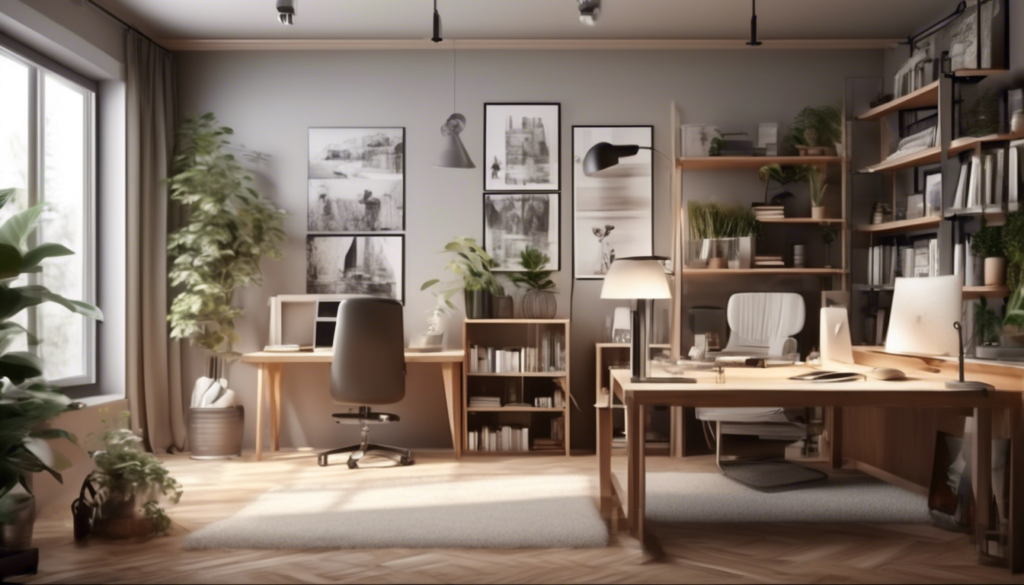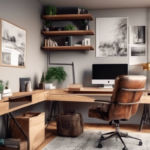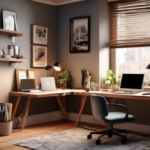Essential Elements to Consider When Structuring a Home Office
Structuring a home office efficiently is crucial for productivity and comfort. Whether you are transitioning to remote work or need a dedicated space for personal projects, setting up a functional home office requires careful planning and organization. By considering essential elements such as location, furniture, lighting, storage, and personalization, you can create a workspace that promotes focus and well-being.
Choosing the Right Location
Selecting the right location for your home office is the first step in creating a productive work environment. Ideally, choose a quiet area away from distractions to minimize interruptions. Natural light can have a positive impact on mood and energy levels, so try to position your desk near a window. Consider factors like proximity to power outlets and a strong Wi-Fi signal when choosing a spot for your home office.
Selecting Functional Furniture
Investing in ergonomic furniture is essential for maintaining good posture and preventing discomfort during long work hours. Choose a comfortable chair that provides adequate support for your back. Your desk should be at a suitable height to promote proper wrist alignment while typing. Additionally, consider storage options such as shelves, drawers, or cabinets to keep your workspace organized and clutter-free.
Optimizing Lighting
Good lighting is crucial for reducing eye strain and enhancing productivity. Whenever possible, position your desk near natural light sources to benefit from daylight. Supplement natural light with task lighting, such as a desk lamp, to illuminate your workspace effectively. Adjustable lighting options can help you customize the brightness to suit different tasks throughout the day.
Adequate Storage
An organized workspace contributes to a clear mind and increased efficiency. Integrate storage solutions that accommodate your workflow and keep essentials within reach. Consider using shelves, cabinets, or storage bins to declutter your desk and maintain a tidy environment. Labeling storage containers can further streamline your work processes and help you locate items easily.
Personalizing Your Workspace
Adding personal touches to your home office can make the space more inviting and inspiring. Decorate with plants, artwork, or meaningful items that reflect your personality and interests. elements that spark creativity and motivation can enhance your overall work experience. However, ensure that personalization does not hinder your productivity or create unnecessary distractions.
Structuring a home office involves thoughtful consideration of various elements to create a functional and inspiring workspace. By addressing aspects such as location, furniture, lighting, storage, and personalization, you can design a home office that promotes productivity and well-being. Remember that customization is key to tailoring your workspace to suit your unique preferences and work style. A well-organized and personalized home office can significantly impact your focus, creativity, and overall satisfaction with remote work or personal projects.
Furniture and Equipment Recommendations for an Efficient Home Office Setup
One key aspect of creating an effective home office is selecting the right furniture and equipment. A well-thought-out selection can make a significant difference in your productivity and overall work experience. Here are some recommendations to help you set up an efficient home office space:
Ergonomic Desk and Chair
Investing in an ergonomic desk and chair is crucial for your home office setup. Your desk should have enough space for your computer, paperwork, and other essentials. Ensure that the desk height allows your feet to rest flat on the ground, promoting good posture. Pair it with an ergonomic chair that supports your lower back and promotes healthy sitting habits to prevent any discomfort or strain during long work hours.
Proper Lighting
Good lighting is essential for reducing eye strain and boosting productivity. Natural light is the best option, so try to position your desk near a window. Additionally, consider adding a desk lamp to provide focused lighting for tasks that require extra illumination. Avoid overhead lighting that may cause glare on your computer screen.
Organizational Storage
To maintain a clutter-free workspace, invest in organizational storage solutions. Shelves, filing cabinets, and drawers can help you keep your office supplies and documents neat and easily accessible. A tidy workspace can help improve focus and efficiency.
Technology and Connectivity
Make sure your home office is equipped with reliable technology. This includes a fast and stable internet connection, a computer or laptop, a printer, and other necessary peripherals. Organize your cables to prevent tangling and tripping hazards. Consider investing in cable management solutions to keep your workspace neat and safe.
Personal Touches
Add personal touches to your home office to make it a comfortable and inspiring space. Decorate with plants, artwork, or photos that motivate you. A vision board with your goals and aspirations can serve as a daily reminder of what you are working towards. Personalizing your workspace can boost morale and creativity.
Greenery and Air Quality
Introducing plants to your home office can improve air quality and create a more pleasant work environment. Plants can help reduce stress and increase productivity. Choose low-maintenance plants such as succulents or spider plants if you are new to gardening. Ensure proper lighting and watering to keep your plants healthy.
Sound Management
Consider the noise levels in your home office environment. If you are easily distracted by external sounds, invest in noise-canceling headphones or sound machines to create a peaceful working atmosphere. You can also position your desk away from high-traffic areas in your home to minimize disruptions.
Creating a well-structured home office requires thoughtful planning and consideration. By selecting the right furniture, equipment, and personal touches, you can design a workspace that promotes focus, productivity, and overall well-being. Customize your home office to suit your preferences and work style, ensuring a comfortable and efficient work environment.
Conclusion
Structuring a home office requires thoughtful consideration of various essential elements to ensure a conducive and productive work environment. From choosing the right location within your home to optimizing lighting, storage, and personalization, each factor plays a crucial role in creating a space that enhances focus and efficiency. Remember to prioritize comfort, ergonomics, and organization to support your well-being and productivity while working from home.
Equally important is investing in quality furniture and equipment that align with your work requirements and preferences. A comfortable ergonomic chair, a spacious desk, adequate storage solutions, efficient lighting, and the necessary technology and accessories can significantly impact your overall work experience. By selecting items that promote good posture, reduce eye strain, and support your workflow, you can set yourself up for success in your home office.
When it comes to furniture, consider adjustable pieces that can adapt to your needs throughout the day. A height-adjustable desk allows you to switch between sitting and standing, promoting movement and reducing the risks associated with prolonged sitting. Ergonomic chairs with lumbar support and adjustable features ensure proper spinal alignment and comfort during long working hours. Additionally, storage solutions such as shelves, cabinets, and organizers help keep your workspace clutter-free and organized.
In terms of equipment recommendations, prioritize investing in reliable technology that enhances your efficiency and connectivity. A high-quality computer or laptop, ergonomic keyboard and mouse, dual monitors for multitasking, a good webcam and microphone for virtual meetings, and a reliable internet connection are essential for seamless remote work. Consider noise-canceling headphones or speakers to minimize distractions and create a focused work environment.
Personalizing your home office with inspiring decor, plants, artwork, and personal touches can boost your mood and motivation. Choose colors, textures, and elements that resonate with you and promote a sense of calm and creativity. Incorporate elements that reflect your personality and interests, making your home office a space where you feel inspired and comfortable.
By carefully considering these essential elements and following the recommended furniture and equipment suggestions, you can create a functional, organized, and inspiring home office that supports your productivity and well-being. Remember that the key to a successful home office setup is to tailor it to your specific needs and preferences, creating a space where you can thrive and achieve your professional goals while enjoying the flexibility and comfort of remote work.



